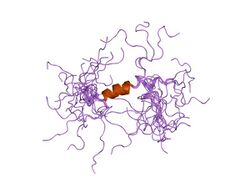Biology:Calcium-activated potassium channel beta subunit
From HandWiki
Revision as of 06:26, 21 October 2021 by imported>S.Timg (linkage)
| CaKB | |||||||||
|---|---|---|---|---|---|---|---|---|---|
 solution structure of the cytoplasmic n-terminus of the bk beta-subunit kcnmb2 | |||||||||
| Identifiers | |||||||||
| Symbol | CaKB | ||||||||
| Pfam | PF03185 | ||||||||
| InterPro | IPR003930 | ||||||||
| SCOP2 | 1jo6 / SCOPe / SUPFAM | ||||||||
| TCDB | 8.A.14 | ||||||||
| |||||||||
In molecular biology, the calcium-activated potassium channel beta subunit is a family of proteins comprising the beta subunits of calcium-activated potassium channels.
The functional diversity of potassium channels can arise through homo- or hetero-associations of alpha subunits or association with auxiliary cytoplasmic beta subunits. The beta subunit (which is thought to possess 2 transmembrane domains) increases the calcium sensitivity of the BK channel.[1] It does this by enhancing the time spent by the channel in burst-like open states. However, it has little effect on the durations of closed intervals between bursts, or on the numbers of open and closed states entered during gating.[2]
References
- ↑ "Functional role of the beta subunit of high conductance calcium-activated potassium channels". Neuron 14 (3): 645–50. March 1995. doi:10.1016/0896-6273(95)90321-6. PMID 7695911.
- ↑ "The beta subunit increases the Ca2+ sensitivity of large conductance Ca2+-activated potassium channels by retaining the gating in the bursting states". J. Gen. Physiol. 113 (3): 425–40. March 1999. doi:10.1085/jgp.113.3.425. PMID 10051518.
 |

